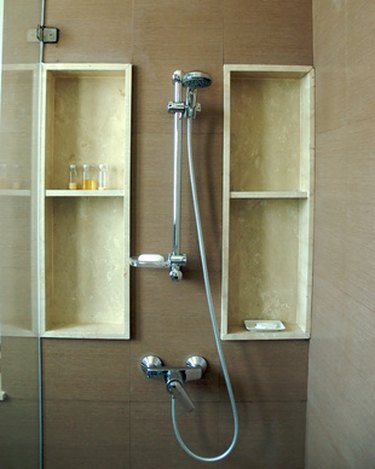Things You'll Need
Work gloves
Utility knife
2-inch putty knife
Electric screwdriver with both various size tips
Flat pry bar
16-ounce claw hammer
12-inch slip pliers
12-inch pipe wrench
Reciprocating saw with an all-purpose blade

There are many reasons why you might want to break down a shower stall. For instance, the space may be needed for other uses, the bathroom is being remodeled or you may have decided to add a Jacuzzi or hot tub. No matter what the reason, dismantling the shower area should be done in a very deliberate and careful manner, for at some point you will need to call in the plumber to cap or redirect the water lines.
Step 1
Take out the doors first. Most likely these partitions come as a pair of sliding units with opaque or translucent glass. Removing the doors might be the easiest part of the whole job, for most shower doors are designed with some vertical play, so they can be installed after the track is put up. This characteristic also makes for easy removal. All you have to do is stand on the inside of the tub and raise one door as high as it will go. This should give you enough height, so you can pull the door into the tub area with you. Then carefully pass the unit to an assistant, who is standing just outside the enclosure.
Video of the Day
Step 2
Take the utility knife and putty blade and use them to remove the waterproof caulking that holds the door frame above the tub. First, use the utility knife to cut all beads of the sealant. Do this on both the inside and outside of the metal track. Then carefully use the putty blade to separate the caulking material from both the metal frame and the tub or tile wall. Once started, the caulking can be pulled by hand, whereabouts it might come out in one piece.
Step 3
Unscrew all screws with an electric screwdriver. These metal fasteners will be inserted through the vertical track pieces into the tile wall. Once the screws are out, remove the top piece first, then the two side tracks and finally the bottom piece that sits on top of the tub sidewall.
Step 4
Disconnect the drain. You might want a plumber to do this, or if you are mechanically-inclined, you can attempt this task yourself. One section of the drain will twist out from inside the tub. Use a pair of locking pliers to turn the top piece if you have to. To get to the underside of the drain, you will probably have to tear out the ceiling from underneath the shower stall or remove the floor boards, if the unit sits on the first floor and their is no basement underneath. Plastic PVC drain can be cut with a saw but metal drain pieces need to be dismantled with a large set of slip pliers or pipe wrenches.
Step 5
Chip away any tile or sheetrock that is built over the sides of the tub. Most modern tubs (and shower units) have a thin flange at the top and sides of the unit. Not only is this flange used as a surface for attaching the enclosure to the wall or floor, but often wallboard and tile may cover the thin strip of metal or plastic to help hold the unit in place. Just take a hammer and an all-purpose chisel and chip away the bottom edge of tile and drywall until the flange is exposed. Then remove all fastening devices from the flange.
Step 6
Check for caulk or silicone beads attached to the outside edge before pulling the base piece away from its permanent location. If present, these items need to be removed as described in Step 2 regarding the door tracks. Also double check that all plumbing hookups are safely disconnected.
Step 7
Remove the tub or shower base from the wall and floor. You can remove a floor tub or shower base yourself and leave the three plumbing fixtures for later, when a plumber is available. However, a full length shower unit will likely involve a visit from a plumber, so the water lines can be disconnected and capped.
Tip
Allow a plumber to disconnect all water lines and to plumb the new unit.
Warning
Be careful working around the water lines. An accidental nick in the water line might be result in a temporary shutdown of the water supply for the building.
Video of the Day